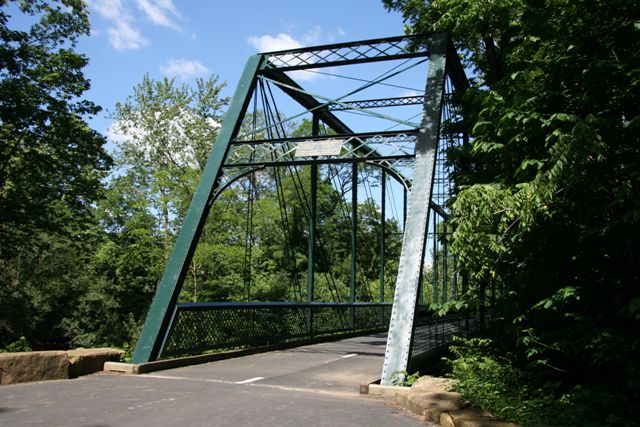We Recommend:
Bach Steel - Experts at historic truss bridge restoration.
Beach Road Bridge

Primary Photographer(s): Rick McOmber
Bridge Documented: June 20, 2010
Westerville: Franklin County, Ohio: United States
1888 By Builder/Contractor: Columbus Bridge Company of Columbus, Ohio
Not Available or Not Applicable
173.0 Feet (52.7 Meters)
179.0 Feet (54.6 Meters)
16 Feet (4.88 Meters)
1 Main Span(s)
2530139

View Information About HSR Ratings
Bridge Documentation
View Archived National Bridge Inventory Report - Has Additional Details and Evaluation
This bridge is rare as a Whipple truss, but is even more rare as a surviving example of a bridge built by the Columbus Bridge Company, a local bridge builder. Only a couple other examples of this company's work appear to remain in the country. This bridge was relocated from Beach Road over Big Darby Creek on the Madison County line.
The historic integrity of the bridge remains good even after this relocation, although the original railings are missing. On the note of railings, the current railing system on the bridge is very heavy and is welded directly to all of the compression vertical members. Further, it is not evident that there are any expansion joints installed on this railing. Because these railings are so massive, because this is a long pin-connected Whipple truss, and because no expansion joints are apparent, these railings may be freezing the bridge up and interfering with the bridge's ability to function correctly. Pin-connected truss bridges are not supposed to be rigid; their members are intended to move and flex. When they cannot move, this tends to present as bowing in the bottom chord and other tension members. While it is not apparent if this is occurring, it was noted that the railing itself appears to be warping, possibly under the stress of the bridge tying to flex as it needs to.
When the Charlotte Highway Bridge was restored, far more lightweight railings were placed on the bridge, yet even with these, expansion joints were specifically installed on the railings to allow the bridge to flex as needed.
Information and Findings From Ohio's Historic Bridge InventorySetting/Context The bridge carries a pedestrian trail/bike path over a stream in Westerville. Integrity Relocated from Beach Road over Big Darby Creek in 1999. Relocated to City of Westerville in 1999. Award October 31, 2000. Summary of Significance The pin-connected double-intersection Pratt thru
truss bridge was relocated in 1999. It retains its integrity of design
and materials. It is a technologically significant example of its
type/design, fabricated by a local bridge company. The eligible
recommendation of the prior inventory remains appropriate. Justification There are 13 examples of the bridge type important to the development and maturation of the pin-connected thru truss bridge. They date from 1881 and concentrate in the 1880s. Even though there are more than 12 extant examples in Ohio, each built in the 1880s has high significance based on overall scarcity (everywhere but in Ohio) of the design. This is a major and technologically significant bridge type. The bridge has high significance. Bridge Considered Historic By Survey: Yes |
This bridge is tagged with the following special condition(s): Reused
![]()
Photo Galleries and Videos: Beach Road Bridge
Bridge Photo-Documentation
Original / Full Size PhotosA collection of overview and detail photos. This gallery offers photos in the highest available resolution and file size in a touch-friendly popup viewer.
Alternatively, Browse Without Using Viewer
![]()
Bridge Photo-Documentation
Mobile Optimized PhotosA collection of overview and detail photos. This gallery features data-friendly, fast-loading photos in a touch-friendly popup viewer.
Alternatively, Browse Without Using Viewer
![]()
Maps and Links: Beach Road Bridge
Coordinates (Latitude, Longitude):
Search For Additional Bridge Listings:
Bridgehunter.com: View listed bridges within 0.5 miles (0.8 kilometers) of this bridge.
Bridgehunter.com: View listed bridges within 10 miles (16 kilometers) of this bridge.
Additional Maps:
Google Streetview (If Available)
GeoHack (Additional Links and Coordinates)
Apple Maps (Via DuckDuckGo Search)
Apple Maps (Apple devices only)
Android: Open Location In Your Map or GPS App
Flickr Gallery (Find Nearby Photos)
Wikimedia Commons (Find Nearby Photos)
Directions Via Sygic For Android
Directions Via Sygic For iOS and Android Dolphin Browser
USGS National Map (United States Only)
Historical USGS Topo Maps (United States Only)
Historic Aerials (United States Only)
CalTopo Maps (United States Only)

